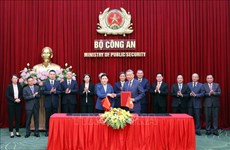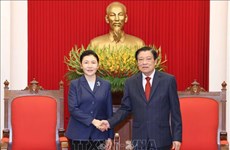Diplomatic corps visit Ho Dynasty Citadel in Thanh Hoa
The
citadel of the Ho Dynasty, also called Tay Do Citadel, is situated in
Vinh Tien and Vinh Long communes, Vinh Loc district, west of Thanh Hoa
city.
Built about 600 years ago, with four gates in the central
of each of the walls South, North, East and West, the Ho Dynasty Citadel
is an old military construction of great cultural and historical value.
It was the old capital of Vietnam from 1397 to 1407.
The
citadel includes three sections: A bamboo hedge, a moat and the citadel
wall plus the internal area with several palaces connected to each
other by marble-paved roads.
In 2004, Vietnamese and Japanese
archaeologists conducted initial excavations in the central area in the
citadel and found architectural traces of old palaces. In 2010, they
discovered the foundation and the main part of the Nam Giao, an elevated
platform for royal rituals worshiping the Heaven and the Earth, about
30cm under the ground.
The excavations also revealed thousands of
artefacts believed to belong to the Ho Dynasty and ceramics of Vietnam
and China, proving cultural exchanges had existed at the time
between Vietnam and neighbouring countries.
Thanh Hoa
province has submitted the complete dossier on the Ho Dynasty Citadel to
the United Nations Educational, Scientific and Cultural Organisation
(UNESCO) for consideration and recognition as a world heritage site.
Katherine
Muller-Marin, Chief Representative of UNESCO in Vietnam, said she
was impressed by the construction of the citadel which used large stone
blocks without any adhesive, special design of the Nam Giao Platform as
well as Ho Quy Ly’s renovation thought, describing them as important
things in documents on the citadel and the roadmap to become a world
heritage site.
Besides the UNESCO representative, the delegation
included diplomats of five permanent member countries at the World
Heritage Committee and representatives from China, Cambodia, Myanmar,
Austria, Indonesia, Morocco, Russia, Germany and Belgium./.













